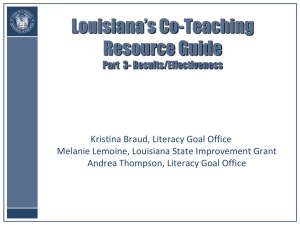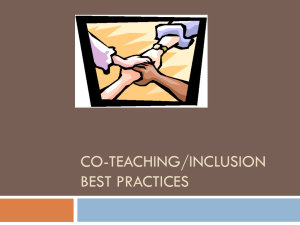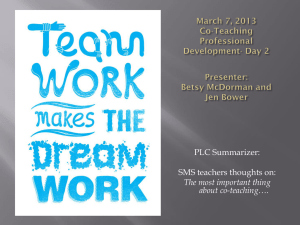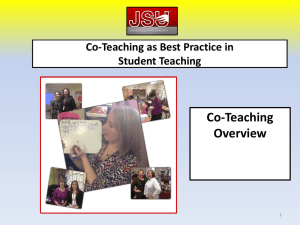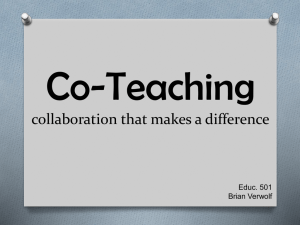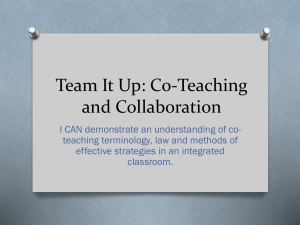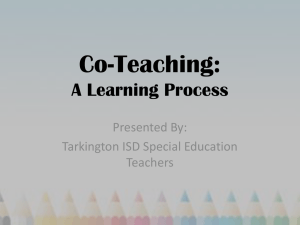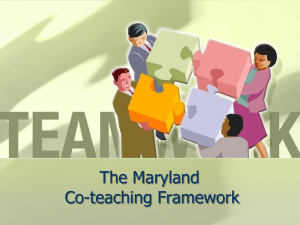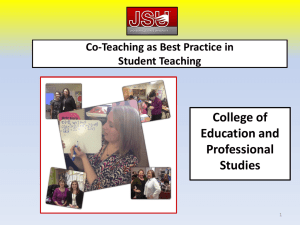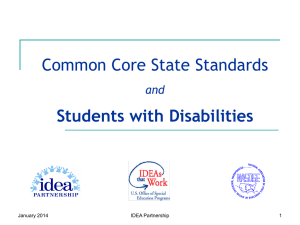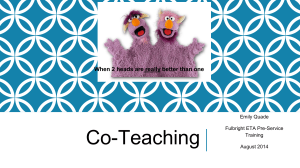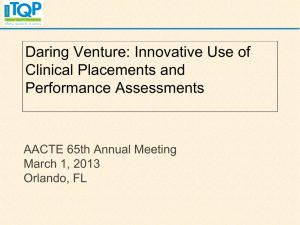Occupational Course of Study and High School Mathematics
advertisement
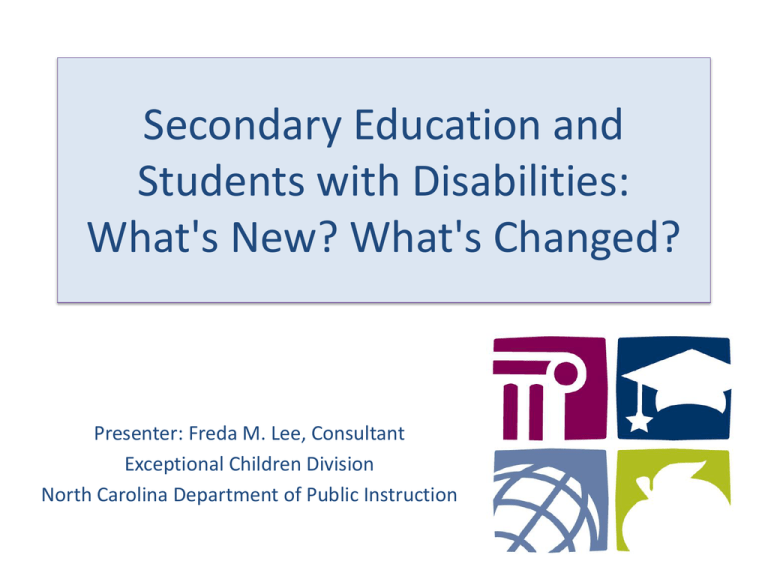
Secondary Education and Students with Disabilities: What's New? What's Changed? Presenter: Freda M. Lee, Consultant Exceptional Children Division North Carolina Department of Public Instruction High School Has Changed!!!!!!! EC Headcount (Ages 14-21) Source: U.S. Department of Education, EDFacts (SY2010-1011) Disability Category Intellectual Disabilities Age 14 15 16 17 18 19 20 21 1,687 1,715 1,877 1,938 1,597 645 290 176 Deaf/Hard of Hearing 148 145 162 127 97 33 11 4 Speech /Language 200 123 73 44 15 10 5 1 Visual Impairment 42 38 45 38 25 10 6 0 713 734 773 686 350 102 29 8 73 80 64 67 42 6 4 3 Other Health Impairment 3,202 2,976 2,754 2,377 1,355 331 58 14 Specific Learning Disabilities 6,174 5,975 5,499 4,833 3,008 778 118 25 2 5 3 2 2 2 2 0 Multiple Disabilities 148 146 121 150 120 110 91 61 Autism 733 676 610 514 395 170 140 82 36 46 40 54 28 11 5 2 13,158 12,659 12,021 10,830 7,034 2,208 759 376 Severe Emotional Disabilities Orthopedic Impairment Deaf-blindness Traumatic Brain Injury Developmental Delay Total How Are We Doing? Graduation Trend Data General Population Four-Year Rate 2006 2007 2008 2009 2010 68.3% 69.5% 70.3% 71.8% 74.2% 50.0% 49.4% 56.6% 56.8% 57.6% 2006 5.04% 2007 5.24% 2008 4.97% 2009 4.27% 2010 Not Available 9.21% 7.79% 8.0% 5.2% Not Available SWDs Four-Year Rate Dropout Trend Data General Population SWDs Indicator 14 Engagement Rate for Students with Disabilities NC 2011 Post-School Outcomes Survey 100% 80% 70% 58% 60% 40% 34% 30% 20% 0% Percent Count Measurement A: 34% Measurement B: 58% Measurement C: 70% Not Engaged 30% 214 365 436 189 What’s New • Large Increase in Co-Teaching and Inclusive Classrooms (HQ and NCLB Requirements) • New Standards (Essential and Common Core) • New Accountability Model • New Teacher Evaluation Method • Increased Use of Technology • New More Rigorous Occupational Course of Study and Extended Standards RtI Secondary Pilot Project • March 2011-2013 • Three sites – Asheville City Schools • Randolph Learning Center • Asheville Middle School – Cabarrus County Schools • Jay Robinson High School • Winkler Middle School – Johnston County Schools • South Johnston High School • Benson Middle School RtI: What’s Going On? • • • • Established leadership teams Looking at Universal Screening Training in Problem-Solving Training in Content Literacy Continuum – Content Enhancement Strategies – Xtreme Reading • Goal: Demonstration sites for the state The Occupational Course of Study (OCS) assessments did not meet approval through the peer review process because the OCS curriculum had different academic content standards than the general curriculum for the assessments used for adequate yearly progress (AYP) purposes. Problem: North Carolina and the Federal Government had different ways of modifying and accommodating for the 2% population who are most typically in the FR-OCS in NC. FR-OCS Standards North Carolina USDE Can be Different FR-OCS Tests Can be Different FR-OCS Cut Scores Can be Different from General from General Cannot be Different Can be Different Can be Different from General from General from General from General 10 Solution: • Move up the timeline for FR-OCS students to be taught the new Common Core/Essential Standards with crosswalks to the NC Standard Course of Study for the assessed subjects • Require FR-OCS students to take certain End-of Course (EOC) assessments in English I (along with the Grade 10 Writing assessment), Algebra I and Biology until new NCEXTEND II assessments are developed • Allow the FR-OCS students’ scores from a combination of the English I EOC assessment and the Grade 10 Writing assessment, Algebra I, and Biology to be included in AYP • Waive 25% requirement in SBE Policy (GCS-C-003) • Eliminate the current OCS NCEXTEND II assessments from the statewide testing program and ABCs accountability program (GCS-C-020). Create new EXTEND II assessments to be used by students participating in the FR-OCS and other students with disabilities • Future-Ready OCS Science Sequence Applied Science Note: All classes require a HQ Teacher of Science Biology aligned exactly to NC Essential Standards Settings – General Education Co-Teaching Class – Exceptional Children Co-Teaching Class – Exceptional Children Class w/dually certified EC teacher – OCS/NCVPS Co-Teaching Class OCS-Biology Future-Ready OCS English I-IV Sequence English I English II English III English I to be closely aligned to Common Core English II to be aligned exactly to Common Core English III and English IV extended from Common Core (more applied) All classes require a HQ Teacher of English Settings General Education Co-Teaching Class Exceptional Children Co-Teaching Class OCS/NCVPS Co-Teaching Class Exceptional Children Class w/dually certified EC teacher English IV Future-Ready OCS Math Sequence Introduction to Mathematics OCS-Algebra I Note: All classes require a HQ Teacher of Mathematics Algebra aligned exactly to Common Core Settings – – – – General Education Co-Teaching Class Exceptional Children Co-Teaching Class OCS/NCVPS Co-Teaching Class Exceptional Children Class w/dually certified EC teacher Financial Management Alternate Assessments Operational 2010-11 Math General Algebra I /No Alt. English Science 2011-12 Same 2012-13 Algebra I NCEXTEND2 General English I/No Alt. General Writing/No Alt. Same Note: Writing Removed English II NCEXTEND2 Note: Writing Removed General Biology/No Alt. Same Biology NCEXTEND2 Field Tests Math Item Tryouts Field Tests Spring 2012 Operational English Item Tryouts Field Tests Spring 2012 Operational Science Item Tryouts Field Tests Fall 2011 Operational Models of Implementation: Co-Teaching General Education Classroom • Promotes inclusion • Requires lots of collaborative planning and professional development • Requires shared teaching responsibilities • Requires use of differentiated instruction and Principles of Universal Design (UDL) • Requires classroom support structures (individual tutoring, assistive technology and close monitoring of student progress) Models of Implementation: Co-Teaching Special Education Classroom • Familiar environment for students • Requires lots of collaborative planning and professional development • Requires shared teaching responsibilities • Requires use of differentiated instruction and Principles of Universal Design (UDL) • Requires fewer outside classroom support structures due to smaller class size and more flexible pacing • Can be difficult to maintain class rigor and pace Models of Implementation: Dually Certified EC Teacher Provides Instruction • Familiar environment for students • EC teacher may not be comfortable teaching certain content areas or units due to lack of familiarity with curriculum reforms in subject area • Requires use of labs or materials not typically available in EC classrooms • Requires use of differentiated instruction and Principles of Universal Design (UDL) • Requires fewer outside classroom support structures due to smaller class size and more flexible pacing • Can be difficult to maintain class rigor and pace Models of Implementation: OCS/NCVPS Blended Online Co-Teaching Classroom • Technology infrastructure issues • Comfort/skill level of EC teacher and students with technology • Provides excellent documentation of instruction provided • Requires lots of collaborative planning • Requires shared teaching responsibilities • Requires use of differentiated instruction and Principles of Universal Design (UDL) • Provides access to all written text in audio format Interactive Games: Equation Matching Interactive Games: Space Invader Graphing Graphing Calculators Virtual Teaching Using Pronto Daily Announcements Mastery Tests Instructional Videos Universal Design for Learning (UDL) and Measures of Student Learning (MSL) • • • • • • • CAST.org (great resource) Relevant and/or applied Hands-on Formative, Benchmark and Summative Built-in Scaffolding Rigorous Encourage higher level thinking in regards to application • THINK OUTSIDE THE BOX!!!!!!!!!!!
